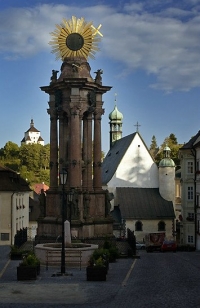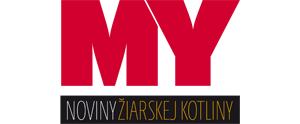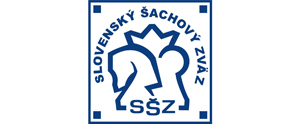Banská Štiavnica
 Banská Štiavnica – a unique town with an unrepeatable atmosphere. There are 201 national cultural monuments and sites on the territory of the town. The historic centre of the town and technical sites in its surroundings were inscribed in the World Cultural and Natural Heritage List supervised by UNESCO in 1993. The history of the town started to be written not later than 1238 when Banská Štiavnica was granted privileges of a royal town. The history of Banská Štiavnica from its beginnings is closely connected with mining what is evidenced by its coat of arms where a silver fortification and golden mining tools are depicted on a blue shield. From the 13 th to the 18 th century Banská Štiavnica's ore region was in some periods the most productive out of all mining regions in Europe with regard to extraction of silver and ranked among the most significant producers of gold.
Banská Štiavnica – a unique town with an unrepeatable atmosphere. There are 201 national cultural monuments and sites on the territory of the town. The historic centre of the town and technical sites in its surroundings were inscribed in the World Cultural and Natural Heritage List supervised by UNESCO in 1993. The history of the town started to be written not later than 1238 when Banská Štiavnica was granted privileges of a royal town. The history of Banská Štiavnica from its beginnings is closely connected with mining what is evidenced by its coat of arms where a silver fortification and golden mining tools are depicted on a blue shield. From the 13 th to the 18 th century Banská Štiavnica's ore region was in some periods the most productive out of all mining regions in Europe with regard to extraction of silver and ranked among the most significant producers of gold.
In 1762, when Maria Theresa established Mining Academy – first technical educational institution of university character in the world, Banská Štiavnica became a centre of development of mining science and technology in Europe. The economic development was accompanied by building and cultural flowering. Large rebuilding was recorded in the town in the 16th century when under the threat of Turkish danger, the town was enclosed by a double belt of fortification with gates on the access roads and two Renaissance anti Turkish fortresses, the New and the Old castles. The heart of the town, Holy Trinity Square, is surrounded by pompous burgher houses. In the centre of the square towers a plague column with a statuary of the Holy Trinity from the beginning of the 18th century. The architectural gems of the town include the sacred structures: the late gothic St. Catherine Church, the Church of the Assumption of the Wirgin Mary, the classicist Evangelical Church which take breath away by their beauty. One of the most beautiful dominants of the town, which attracts attention even from far away, is the baroque Calvary. It is a complex of sacred structures sensitively placed in the natural environment. Worth of mentioning are also buidings, e.g. the Kammerhof – seat of the mining chamber, the Town Hall, the Kocking Tower and 11 objects of the former Mining Academy.
 Nature – The protected landscape area of the Štiavnica Hills extends on the area of 77 630 ha. With regard to the area, the Štiavnica Hills are the largest volcanic mountain range in Slovakia with diverse flora and fauna, and with a lot of historic and technical monuments and sites on their territory. There described more than 80 minerals within this area out of which worth of mentioning is the unique scepter quartz. Precious in the region are mineral springs which well out in Sklené Teplice and Vyhne. The highest summit of the Štiavnica Hills is Sitno – 1009 m above sea level. The national natural reserve of Sitno is a habitat for several protected plants and animals. The archeological finds evidence that the top of Sitno emblazoned with legends was settled as early as the Primeval Ages. There are preserved remnants of a stone castle from the Middle Ages. Mining activities left traces on the landscape character. The development of mining continuously required new methods of ore exploitation, water pumping and improved of treatment devices. From the beginning of the 16th to the middle of the 19th century in the region of Banská Štiavnica there was build a unique water management system consisting of 60 manmade water reservoirs with the total volume 7 milion m3. The reservois were mutually interconnected by collecting, trunk and joining trenches. Due to shortage of natural water sources in the region, snow and rain water was caught in collecting trenches and cumulated in the water reservoirs. Out of them, the water distributed by the trunk trenches to different mining equipments. At present, 23 water reservoirs are preserved and they serve for recreation and fishing. In the protected landscape area of the Štiavnica Hills one can find 5 instructive trails and a lot of hiking routes which reveal to their visitors not only natural sceneries, but also works of human and craftsmanship sensitively laid in the natural environment.
Nature – The protected landscape area of the Štiavnica Hills extends on the area of 77 630 ha. With regard to the area, the Štiavnica Hills are the largest volcanic mountain range in Slovakia with diverse flora and fauna, and with a lot of historic and technical monuments and sites on their territory. There described more than 80 minerals within this area out of which worth of mentioning is the unique scepter quartz. Precious in the region are mineral springs which well out in Sklené Teplice and Vyhne. The highest summit of the Štiavnica Hills is Sitno – 1009 m above sea level. The national natural reserve of Sitno is a habitat for several protected plants and animals. The archeological finds evidence that the top of Sitno emblazoned with legends was settled as early as the Primeval Ages. There are preserved remnants of a stone castle from the Middle Ages. Mining activities left traces on the landscape character. The development of mining continuously required new methods of ore exploitation, water pumping and improved of treatment devices. From the beginning of the 16th to the middle of the 19th century in the region of Banská Štiavnica there was build a unique water management system consisting of 60 manmade water reservoirs with the total volume 7 milion m3. The reservois were mutually interconnected by collecting, trunk and joining trenches. Due to shortage of natural water sources in the region, snow and rain water was caught in collecting trenches and cumulated in the water reservoirs. Out of them, the water distributed by the trunk trenches to different mining equipments. At present, 23 water reservoirs are preserved and they serve for recreation and fishing. In the protected landscape area of the Štiavnica Hills one can find 5 instructive trails and a lot of hiking routes which reveal to their visitors not only natural sceneries, but also works of human and craftsmanship sensitively laid in the natural environment.

















 Slovensky
Slovensky 










